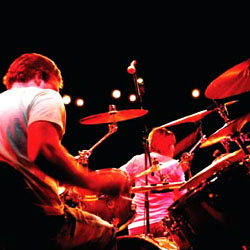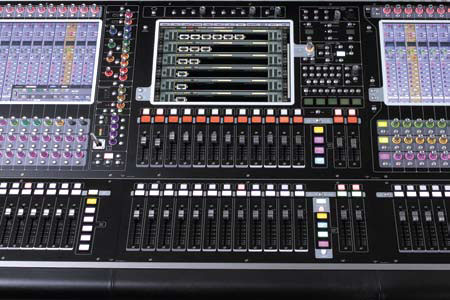
Parallel Processing
Following the trend in recording, stereo bus compressors are becoming more common in live sound to tighten and polish the drum kit.
An alternative to inserting into individual channels, feeding a compressor from an auxiliary bus and returning it to the main mix is a type of parallel compression, referred to as “New York Compression” in studio circles.
Parallel compression passes a portion of the mix to a compressor while also assigning it directly to the mix. It allows the engineer to fatten up certain parts of the mix, usually drum inputs.
I discovered it in my youth at the Beacon Theater when Dokken’s front of house engineer had me patch a dbx 160x from an aux and back to a channel. He liked it so much that he bought my 160x on the spot.
Double assigning drum inputs to a compression sub-group (in addition to the main mix), is another parallel compression approach.
The advantage of using a compression auxiliary send, instead of a compression sub-group, is that the balance going to the compressor is easily altered (especially with a digital console’s “faderflip”) allowing the engineer to reduce the overheads, for example. It’s common for group compression to require a little post-compression EQ on its return channels to contour the sound further.
Parallel processing in the digital world, especially with plug-ins, can add several milliseconds of latency relative to the same unprocessed inputs in the mix.
Latency can produce comb filtering, having a “phasey” effect on the sound if the console doesn’t have “delay compensation” to match the unprocessed sound to the late arrival of the processed sound.
With the advent of Waves Multi- Rack or SoundGrid, as well as FireWire consoles, live sound plug-ins became available to more live engineers than ever. The multitude of plugs imitating classic equipment offers engineers a virtual palette of vintage optical and tube compressors.
The Waves SSL Buss Compressor or the API 2500 have been popular for their colored vintage emulation, along with Avid Smack! and Bomb Factory BF-2A and BF-76, bundled with Avid Venue consoles.
Some prefer multi-band control and more transparency, such as the TC Electronic Master X3 or MD 3 mastering plug-in. DiGiCo SD digital consoles come with 3-band compressors built-in. Midas and Yamaha consoles have stereo 3-band compressors in their effects libraries.
While this uses up one of the effects engines, it provides a powerful way to enhance drum sounds, which is why I like it for IEM applications. Beware, as with any effect, a little goes a long way and too much can be annoying.
Make A Scene
The work-flow of preparing the digital console’s file in advance creates the illusion and expectation that the desk can be quickly adjusted. In reality it actually takes more time with a digital desk until you get your methods and file structures organized.
However, much of that time can be invested before the band is on stage and, by using off-line software with a laptop, long before the console is even turned on. Today there’s increased pressure for engineers to be able to open their faders and mix at a moment’s notice, even in one-off and festival situations.
Many details go into building great drum sounds. EQ, dynamics and effects libraries can be helpful when there’s time to build drum sounds from the ground up. Other times an engineer will have just a few minutes to get drum sounds. Having a generic scene ready to go can save an enormous amount of time.
Most input lists begin with a fairly standard sequence of drum inputs (KKSSH1234OO), so loading an entire scene with a well-tempered file from a previous show – even from a different band – can give a similar drum kit with the same mics a solid starting place, needing only the other instruments and vocals to be named and tweaked (which again can be done quickly from libraries).
Finally, I recommend dedicating an extra channel to the input list for experimentation, making it easy to try new mics and methods on the drums.
The monitor desk’s input list often includes an extra channel for click track that never appears at front of house, so this can be a good place to add an “X” channel.
Mark Frink is a long-time monitor engineer and professional audio editor and writer. He’s hosting the Live Sound Expo at the 139th AES Convention in New York this October.

